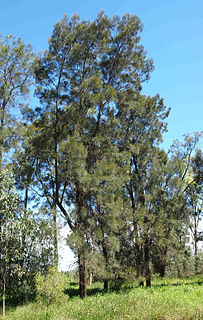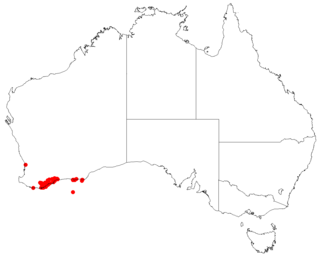
The Casuarinaceae are a family of dicotyledonous flowering plants placed in the order Fagales, consisting of four genera and 91 species of trees and shrubs native to eastern Africa, Australia, Southeast Asia, Malesia, Papuasia, and the Pacific Islands. At one time, all species were placed in the genus Casuarina. Lawrence Alexander Sidney Johnson separated out many of those species and renamed them into the new genera of Gymnostoma in 1980 and 1982, Allocasuarina in 1982, and Ceuthostoma in 1988, with some additional formal descriptions of new species in each other genus. At the time, it was somewhat controversial. The monophyly of these genera was later supported in a 2003 genetics study of the family. In the Wettstein system, this family was the only one placed in the order Verticillatae. Likewise, in the Engler, Cronquist, and Kubitzki systems, the Casuarinaceae were the only family placed in the order Casuarinales.

Allocasuarina is a genus of trees in the flowering plant family Casuarinaceae. They are endemic to Australia, occurring primarily in the south. Like the closely related genus Casuarina, they are commonly called sheoaks or she-oaks.

Casuarina is a genus of 17 tree species in the family Casuarinaceae, native to Australia, the Indian subcontinent, southeast Asia, islands of the western Pacific Ocean, and eastern Africa. It was once treated as the sole genus in the family, but has been split into four genera.

Allocasuarina fraseriana, commonly known as western sheoak, common sheoak, WA sheoak. Fraser's sheoak or just sheoak, is a tree in the family Casuarinaceae. Endemic to Western Australia, it occurs near the coast in the south west corner of the State, from Jurien to Albany . The Noongar peoples know the tree as Condil, Kulli or Gulli.

Allocasuarina huegeliana, commonly known as rock sheoak or sighing sheoak, is a tree in the family Casuarinaceae. Endemic to Western Australia, it occurs mostly throughout the Wheatbelt region. It is now especially common on road verges, where it sometimes forms thickets.

Allocasuarina lehmanniana, commonly known as dune sheoak, is a shrub in the family Casuarinaceae. Endemic to Western Australia, it is widespread along on the coast from the Murchison River south to Israelite Bay.

Leucophyta is a plant genus which is endemic to Australia. The genus was first formally described by botanist Robert Brown in 1818.

Allocasuarina distyla, commonly known as scrub she-oak, is a shrub or small tree of the She-oak family Casuarinaceae endemic to New South Wales.

Allocasuarina decaisneana or desert oak is a medium-sized, slow-growing tree found in the dry desert regions of the Northern Territory, South Australia and Western Australia. The Anangu peoples know the tree as kurkara.

Casuarina cristata is an Australian tree of the sheoak family Casuarinaceae known as belah. It is native to a band across inland eastern Australia.

Allocasuarina inophloia, also known as woolly oak, or stringybark she-oak, is a shrub or small tree of the she-oak family Casuarinaceae endemic to inland New South Wales and Queensland. The hairy bark is an unusual feature.

Allocasuarina paludosa, commonly known as the swamp sheoak or scrub sheoak, is a woody shrub of the family Casuarinaceae. It is endemic to south-eastern Australia.

Allocasuarina grampiana, commonly known as Grampians sheoak, is a dioecious shrub or tree of the family Casuarinaceae. The species is endemic to the Grampians in Victoria, Australia where it grows on sandstone outcrops. It grows to between 1 and 4 metres high and has ascending needle-like branchlets to 15 cm long which have a waxy bloom. Cones are cylindrical and are between 13 and 35 mm long and about 8mm in diameter. These produce 5mm long winged seeds.

Allocasuarina decussata, commonly known as karri oak or karri she-oak, is a medium-sized tree, or more rarely a shrub, that is endemic to the south west of Western Australia. It is an understory tree in karri forest but also occurs as a stunted shrub in places like Bluff Knoll in the Stirling Range.

Allocasuarina drummondiana is a shrub of the genus Allocasuarina native to the Wheatbelt region of Western Australia.
Allocasuarina fibrosa, commonly known as the woolly sheoak, is a shrub of the genus Allocasuarina native to a small area in the central Wheatbelt region of Western Australia.

Allocasuarina thuyoides, commonly known as the horned sheoak, is a shrub of the genus Allocasuarina native to a large area in the Mid West, Wheatbelt, South West and Goldfields-Esperance regions of Western Australia.

Allocasuarina trichodon is a shrub of the genus Allocasuarina native to an area along the south coast in the Great Southern and Goldfields-Esperance regions of Western Australia.
Allocasuarina filidens, commonly known as the Mount Beerwah sheoak, is a shrub of the genus Allocasuarina native to Queensland.

Amyema cambagei, commonly known as sheoak mistletoe, is a species of flowering plant, an epiphytic hemiparasitic plant of the family Loranthaceae endemic to Australia, and found in New South Wales and Queensland in sclerophyll forest and woodland on several species of Casuarinaceae.





















